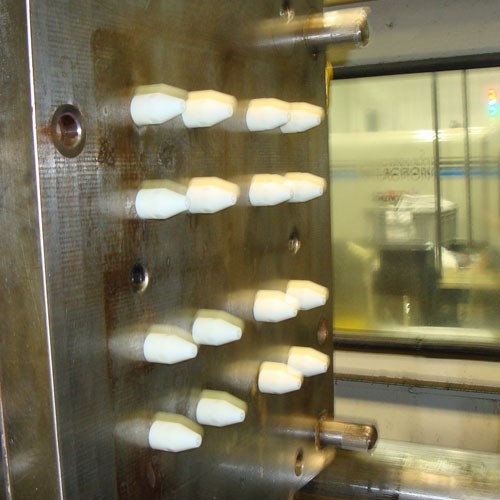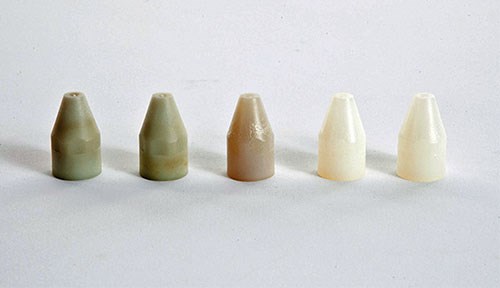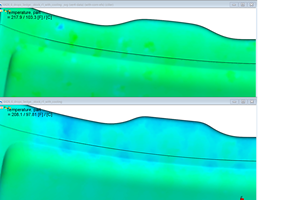Temperature Control Boosts Hot Runner Productivity, Eliminates Burned Parts
“The controllers feature a system that ‘bakes out’ moisture within the heating element at every startup. This reduces downtime—and protects the mold.”
Share
Read Next
Precise control over hot runner temperatures was the key to ending a problem with burned parts that plagued a particular job being run by custom molder American Plastic Molding Corporation (APM; Scottsburg, IN)—enabling the company to increase output of saleable product by 10 to 15 percent. Mold manufacturers that install a quality temperature control on a hot runner system not only lengthen a mold’s life, but they help improve part quality—making both management and customers happy.
Family-owned and -operated since it was founded in 1971, APM is a full-service custom molder that provides extensive engineering services and stages free quarterly seminars on design and engineering for customers and prospects. The company has 38 injection molding machines, an assembly facility with lean manufacturing cells, an on-site mold shop, and a 60,000-square foot warehouse. It provides full engineering services and offers customers supply chain sourcing and management, warehousing and distribution. Employing 120 people, APM serves customers in a wide range of end use industries.
Fast Heat Inc. (Elmhurst, IL) General Manager Sean Rainsford notes that the Ion Series temperature controllers can extend a mold’s life. “The bake-out feature can remove moisture from the mold at every startup,” he explains. “This reduces downtime by protecting the heaters and mold.”
Additionally, the evensoak and waterfall features allow the customer to bring the mold up to temperature efficiently while using 100 amp service. Rainsford adds. “When other controllers have all zones pulling maximum power, there is the risk of opening the circuit breaker and damaging heaters. The downtime is expensive.” In production, the precise temperature control will reduce scrap such as flashing, stringing, and burning. These benefits will also yield lower maintenance costs.
“And, when the mold needs preventive maintenance in the toolroom, the controller diagnostics guarantee the mold is fully operational and ready for production.” Rainsford continues. “Another unique feature is that the PID controller software is constantly tuning to the mold when in use.”
According to Alan Myers, APM plant manager, the part discoloration caused by burning stopped almost immediately after connecting an Ion Series temperature controller to a 16-cavity hot runner system that was producing 30 percent glass-filled nylon 6.6 parts for a Tier 1 supplier to the automotive industry. Within two hours after installing the controller, APM had fine-tuned the system to the point where temperatures were reduced by nearly 70ºF.
“Before we installed the Fast Heat controller, we were unable to reduce the temperature without having gates freeze,” Myers notes, “but within the first couple of hours, it became a question of ‘How low can the temperature go?’ We soon established a new temperature range of 430 to 440 ºF. The lower temperatures increased our output of good parts by 10 to 15 percent and eliminated the labor involved in sorting out parts that were burned.”
The controller connects directly to the hot runner, notes Rainsford. “You simply unwrap the controller, plug it into your tool and flip the switch,” he comments. “It ramps up on its own and gets you and up and running in no time.” He adds that it is so easy to use that newer employees won’t have to be trained. “The user is always one click away from the main screen, no matter where he or she is in the set-up,” Rainsford notes. “One can’t really get ‘lost’ in the program because it is easy to see what is going on.”
Fast Heat’s Ion Series controller has also increased productivity in other ways, according to Myers. The controller allows you to save the mold parameters in a file recipe. And in the event of a thermocouple failure in a zone, the slaving feature allows the operator to operate two zones using one thermocouple.
“In the past, when a zone shut down, we would end up producing from 15 cavities instead of 16, making that much less product during the typical three-day turnaround needed to replace the defective unit,” Myers says.
Installing a temperature controller on a hot runner system protects the mold, reduces downtime and improves productivity. Myers simply states the Ion Series benefit: “It gives us more faith in using hot runner systems.”
For More Information
American Plastic Molding Corp. / (812) 752-7000
sales@apmc.com / apmc.com
Related Content
The In's and Out's of Ballbar Calibration
This machine tool diagnostic device allows the detection of errors noticeable only while machine tools are in motion.
Read MoreThe Trifecta of Competitive Toolmaking
Process, technology and people form the foundations of the business philosophy in place at Eifel Mold & Engineering.
Read MoreQuickly Troubleshoot New Molding Defect with Moldfilling Software
SyBridge Technologies analyst compares original, new Moldflow process simulation results, solves molding defect without tool needing to be taken out of production.
Read MoreOEE Monitoring System Addresses Root Cause of Machine Downtime
Unique sensor and patent-pending algorithm of the Amper machine analytics system measures current draw to quickly and inexpensively inform manufacturers which machines are down and why.
Read MoreRead Next
Hot Runner Temperature Control: A Low-Investment Solution for Challenging Molding
To understand the importance of hot runner controls, you need to examine how they actually control temperature, processing implications and mold design considerations.
Read MoreHow to Use Strategic Planning Tools, Data to Manage the Human Side of Business
Q&A with Marion Wells, MMT EAB member and founder of Human Asset Management.
Read MoreAre You a Moldmaker Considering 3D Printing? Consider the 3D Printing Workshop at NPE2024
Presentations will cover 3D printing for mold tooling, material innovation, product development, bridge production and full-scale, high-volume additive manufacturing.
Read More












_300x250 1.png;maxWidth=300;quality=90)




.jpg;maxWidth=300;quality=90)








